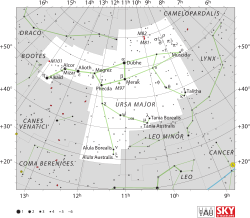Tania Borealis
| Tania Borealis | |
 | |
| Observationsdata Epok: J2000 | |
|---|---|
| Stjärnbild | Stora Björnen |
| Rektascension | 10t 17m 05,78287s[1] |
| Deklination | +42° 54′ 51,6808″[1] |
| Skenbar magnitud () | +3,45[2] |
| Stjärntyp | |
| Spektraltyp | A2 IV[3] |
| U–B | +0,06[4] |
| B–V | +0,03[4] |
| Astrometri | |
| Radialhastighet () | +18,1[5] km/s |
| Egenrörelse (µ) | RA: -180,65[1] mas/år Dek.: -45,07[1] mas/år |
| Parallax () | 23,72 ± 0,78[1] |
| Avstånd | 138 ± 5 lå (42 ± 1 pc) |
| Absolut magnitud () | +0,10[6] |
| Detaljer | |
| Massa | 2,1[7] M☉ |
| Radie | 2,3[8] R☉ |
| Luminositet | 37[8] L☉ |
| Temperatur | 9 247 ± 314[7] K |
| Metallicitet | +0,20[9] dex |
| Vinkelhastighet | 50[10] km/s |
| Ålder | 380[7] miljoner år |
| Andra beteckningar | |
| 33 Ursae Majoris, HD 89021[11], HIP 50372[11], SAO 43268[2], FK5 383[2] | |
Tania Borealis,[12] eller Lambda Ursae Majoris (λ Ursae Majoris, förkortat Lambda Uma, λ UMa) som är stjärnans Bayer-beteckning, är en ensam stjärna i den sydöstra delen av stjärnbilden Stora Björnen och är baktassen hos björnen.[13] Den har en skenbar magnitud på +3,45[2] och är synlig för blotta ögat där ljusföroreningar ej förekommer. Baserat på parallaxmätningar i Hipparcos-uppdraget på 23,7[1] mas beräknas den befinna sig på ca 138 ljusårs (42 parsek) avstånd från solen.
Nomenklatur
[redigera | redigera wikitext]Lambda Ursae Majoris de traditionella namnen Tania (delat med My Ursae Majoris) och Tania Borealis. Tania kommer från den arabiska frasen Al Fiḳrah al Thānia "Andra våren (för Gazellen)"[14] och Borealis (ursprungligen borealis[15]) är latin för "norra sidan". År 2016 organiserade Internationella astronomiska unionen en arbetsgrupp för stjärnnamn (WGSN)[16] med uppgift att katalogisera och standardisera riktiga namn för stjärnor. WGSN fastställde i juli 2016 namnet Tania Borealis för Lambda Ursae Majoris, vilket nu ingår i listan över IAU-godkända stjärnnamn.[17]
Egenskaper
[redigera | redigera wikitext]Tania Borealis är en blå till vit underjättestjärna av spektralklass A2 IV.[3] Den har en massa som är ca 2,1[7] gånger solens massa, en radie som är ca 2,3[8] gånger större än solens och utsänder ca 37[8] gånger mera energi än solen från dess fotosfär vid en effektiv temperatur på ca 9 200 K.[7]
Referenser
[redigera | redigera wikitext]- Den här artikeln är helt eller delvis baserad på material från engelskspråkiga Wikipedia, Lambda Ursae Majoris, 19 mars 2019.
Noter
[redigera | redigera wikitext]- ^ [a b c d e f] van Leeuwen, F. (November 2007), "Validation of the new Hipparcos reduction", Astronomy and Astrophysics, 474 (2): 653–664, arXiv:0708.1752, Bibcode:2007A&A...474..653V, doi:10.1051/0004-6361:20078357
- ^ [a b c d] ”The stars of Ursa Major” (på engelska). Bright Star Catalogue. Astronomical Data Center. http://www.alcyone.de/SIT/bsc/uma.html. Läst 13 februari 2016.
- ^ [a b] Cowley, A.; et al. (April 1969), "A study of the bright A stars. I. A catalogue of spectral classifications", Astronomical Journal, 74: 375–406, Bibcode:1969AJ.....74..375C, doi:10.1086/110819
- ^ [a b] Johnson, H. L.; et al. (1966), "UBVRIJKL photometry of the bright stars", Communications of the Lunar and Planetary Laboratory, 4 (99), Bibcode:1966CoLPL...4...99J
- ^ Evans, D. S. (June 20–24, 1966), "The Revision of the General Catalogue of Radial Velocities", in Batten, Alan Henry; Heard, John Frederick, Determination of Radial Velocities and their Applications, Proceedings from IAU Symposium no. 30, University of Toronto: International Astronomical Union, Bibcode:1967IAUS...30...57E
- ^ Eggen, Olin J. (July 1998), "The Age Range of Hyades Stars", The Astronomical Journal, 116 (1): 284–292, Bibcode:1998AJ....116..284E, doi:10.1086/300413.
- ^ [a b c d e] David, Trevor J.; Hillenbrand, Lynne A. (2015), "The Ages of Early-Type Stars: Strömgren Photometric Methods Calibrated, Validated, Tested, and Applied to Hosts and Prospective Hosts of Directly Imaged Exoplanets", The Astrophysical Journal, 804 (2): 146, arXiv:1501.03154, Bibcode:2015ApJ...804..146D, doi:10.1088/0004-637X/804/2/146.
- ^ [a b c d] Malagnini, M. L.; Morossi, C. (November 1990), "Accurate absolute luminosities, effective temperatures, radii, masses and surface gravities for a selected sample of field stars", Astronomy and Astrophysics Supplement Series, 85 (3): 1015–1019, Bibcode:1990A&AS...85.1015M
- ^ Hill, G. M. (February 1995), "Compositional differences among the A-type stars. 2: Spectrum synthesis up to V sin i = 110 km/s", Astronomy and Astrophysics, 294 (2): 536–546, Bibcode:1995A&A...294..536H
- ^ Royer, F.; Zorec, J.; Gómez, A. E. (February 2007), "Rotational velocities of A-type stars. III. Velocity distributions", Astronomy and Astrophysics, 463 (2): 671–682, arXiv:astro-ph/0610785, Bibcode:2007A&A...463..671R, doi:10.1051/0004-6361:20065224
- ^ [a b] ”Tania Borealis - Lambda Ursae Majoris” (på engelska). Universe Guide. https://www.universeguide.com/star/taniaborealis. Läst 13 februari 2016.
- ^ "IAU Catalog of Star Names". Hämtad 28 juli 2016.
- ^ ”TANIA BOREALIS” (på engelska). Constellations Of Words. http://www.constellationsofwords.com/stars/TaniaBorealis.html. Läst 13 februari 2016.
- ^ Richard Hinckley Allen :Star Names — Their Lore and Meaning - Ursa Major, the Greater Bear
- ^ Piazzi, G., The Palermo Catalogue, Palermo, 1814.
- ^ IAU Working Group on Star Names (WGSN)". Hämtad 22 maj 2016.
- ^ "Bulletin of the IAU Working Group on Star Names, No. 1" (PDF). Retrieved 28 July 2016.
Externa länkar
[redigera | redigera wikitext]- https://en.wikipedia.org/wiki/Lambda_Ursae_Majoris
- http://stars.astro.illinois.edu/sow/taniabor.html





